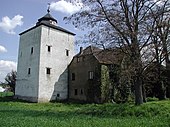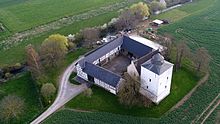Arloff Castle
| Arloff Castle | ||
|---|---|---|
|
The residential tower and outbuildings of Arloff Castle from the north |
||
| Creation time : | 12./13. century | |
| Castle type : | Niederungsburg | |
| Conservation status: | Preserved essential parts | |
| Construction: | Quarry stone | |
| Place: | Arloff | |
| Geographical location | 50 ° 35 '33 " N , 6 ° 47' 13.7" E | |
| Height: | 225 m above sea level NHN | |
|
|
||
The castle Arloff situated on the river Erft in the district Arloff the city of Bad Münstereifel in Euskirchen , North Rhine-Westphalia.
The group of buildings of the former Arloff moated castle , which today seems rather inconspicuous on the Erft, is one of the typologically important castles in the Rhineland . Because a purpose-oriented defense structure from the early Gothic period is rarely found in such clarity.
Originally it was surrounded by ditches that were fed by the Erft. In the Middle Ages it was of strategic importance because of its location, as it was on the border between the Electorate of Cologne and the County of Jülich .
history
Arloff Castle was first mentioned in 1278. The castle and associated lands were owned by the "Gerlach von Dollendorf" in 1278, whose family, the noble von Dollendorf family, resided at their ancestral home in the Dollendorf-Schloßthal castle near Blankenheim from 893 until the middle of the 15th century. At the time, the Dollendorfer were among the oldest and richest noble houses in the region. Gerlach, of its ownership in Arloff in 1278 the Cologne archbishop Siegfried to feudal auftrug, this had been forced already with the co-owned the "Dollendorfer" castle and its lands in the neighboring "Kirspenich".
The balance of power changed ten years later when the "Jülich" in 1288 in the battle of Worringen on the side of the victors against "Siegfried". The Count von Jülich, who belonged to the victorious party, succeeded as feudal lord, but had little interest in the small castle. In order not to argue further about the castle, its respective owner was appointed to the state parliaments of both principalities. This compromise was sustainable for the next 500 years.
In the 15th and 16th centuries the "Lords of Mirbach" owned Arloff Castle, followed by "von Friemersdorf" in the 17th century. "Werner Dietrich von Friemersdorf," called Pützfeld, sold his allodial knight's seat at Arloff next to the mill and other "Appertinentien" (accessories, related goods) to "Philipp Wilhelm von Mockel", mayor of Cologne . He had an existing house converted into a tenant house; he himself owned Arloff Castle until 1712.
Residential tower
Central is the unique residential tower from 1269, which has been preserved in its original form. The three-storey building, now plastered from quarry stone , was built over an older and originally smaller barrel-vaulted cellar. Due to the good condition of the existing original beams, the dendrochronological examinations carried out on them made it possible to determine the felling time of the tree trunks and their processing year. Accordingly, the wood processed in the tower was felled in the autumn of 1269 and processed in 1270. In this way, the year of construction could be verified for the majority of the residential tower. Apparently only two upper floors were inhabited as these, in contrast to the last floor with only narrow light slits, have quite large windows. The roof, which dates from the 18th century, is similar to that of the “sister castle ” in Kirspenich as a tower roof . The tower was probably no longer inhabited at that time, as the roof structure had been pulled over the chimney .
The baroque house from 1699, also made of quarry stone, is placed in front of the residential tower next to a building that possibly served as a kennel in the 15th to 16th centuries . Since the residential tower was once free-standing and secured with moats , it can be assumed that there was a connection to the nearby Erft, where the old mill, which was owned by the lord of the castle, is still located today .
Web links
- Entry by Alexandra Zingler about Arloff in the scientific database " EBIDAT " of the European Castle Institute
Individual evidence
- ↑ : Dirk Holtermann, Harald Herzog: Die Euskirchener Burgenrunde - Cycling between Erft and Eifel, Bouvier Verlag, Düsseldorf 2000, ISBN 978-3-416-02977-3 , p. 57.
- ↑ Dirk Holtermann, Harald Herzog, p. 57
- ↑ Harald Herzog, Klaus Ring, with reference to H. Herzog, Burgen Euskirchen p. 144 ff and H. Kisky, p. 80
- ↑ Burg Heimerzheim archive, act castle Arloff





